Hawaii Volcanoes National Park
The gateway to exploring the Big Island of Hawaii's volcanoes is the Volcanoes National Park. The park, established in 1916, covers over 500 square miles and reaches from the 13,677 foot summit of Mauna Kea (the largest volcano in the world) to the sea cliffs where molten lava can be seen spewing into the ocean.
Getting There
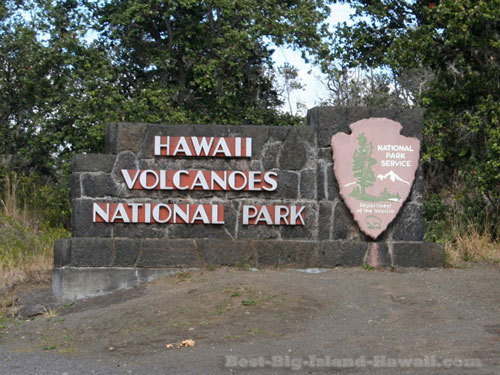 The main entrance to Hawaii Volcanoes National Park is located off of the Big Island's Belt Road (Highway 11) between mile markers 28 and 29, about 96 miles from Kailua-Kona and 30 miles from Hilo. The entrance to the park is well marked and hard to miss. The entrance fee is $10 per vehicle (including all passengers). This fee gives you access to the park for a full week—a pretty good value! Individual and group rates are also available for solo travelers and larger groups.
The main entrance to Hawaii Volcanoes National Park is located off of the Big Island's Belt Road (Highway 11) between mile markers 28 and 29, about 96 miles from Kailua-Kona and 30 miles from Hilo. The entrance to the park is well marked and hard to miss. The entrance fee is $10 per vehicle (including all passengers). This fee gives you access to the park for a full week—a pretty good value! Individual and group rates are also available for solo travelers and larger groups.
National Park enthusiasts know that your entrance fee includes the all-important park brochure, which is not only a handy guide but also a nice keepsake. The Hawaii Volcanoes National Park brochure includes several maps, a geology lesson, a history lesson, a wildlife guide, and a basic guide to enjoying the park's sights.
The Main Sights
For most visitors to Hawaii Volcanoes National Park, your first stop is the Kilauea Visitor's Center, which is open daily from 7:45 am to 5:00 pm (the park itself is open 24 hours to give visitors the opportunity to view lava flows at night). A stop at the Visitor's Center gives you a chance to learn a little more about what you'll be able to see throughout the park. Check out various exhibits on the geological and biological features of the park.
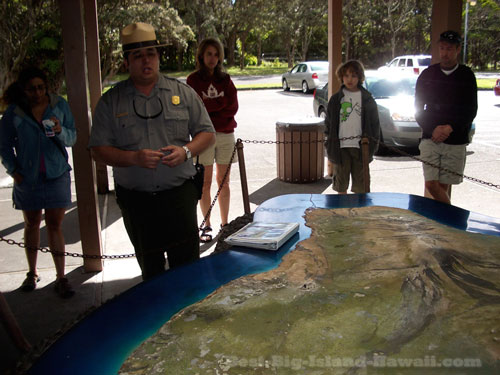 Like all of the National Parks, the Hawaii Volcanoes National Park is staffed by experienced and knowledgeable park Rangers who help guests get the most out of their visit. Rangers give talks at the Visitor's Center and also lead interactive hikes and other programs throughout the park. You can find out about the schedule for these Ranger-led experiences at the Visitor's Center and plan your day accordingly. Also don't forget to ask about the Junior Ranger program for kids 7 - 12. After becoming experts on Hawaii's volcanoes, kids will wear their Junior Ranger badges home with pride!
Like all of the National Parks, the Hawaii Volcanoes National Park is staffed by experienced and knowledgeable park Rangers who help guests get the most out of their visit. Rangers give talks at the Visitor's Center and also lead interactive hikes and other programs throughout the park. You can find out about the schedule for these Ranger-led experiences at the Visitor's Center and plan your day accordingly. Also don't forget to ask about the Junior Ranger program for kids 7 - 12. After becoming experts on Hawaii's volcanoes, kids will wear their Junior Ranger badges home with pride!
Not far from the Visitor's Center is the Volcano House—an interesting hotel that definitely looks like it belongs in a National Park with great views of the Kilauea caldera crater. The Volcano House includes a restaurant, gift shops and a snack bar. Note that the Volcano House will be closed for renovations for much of 2012. The latest information on this temporary closure is available on the park website.
Driving the Park
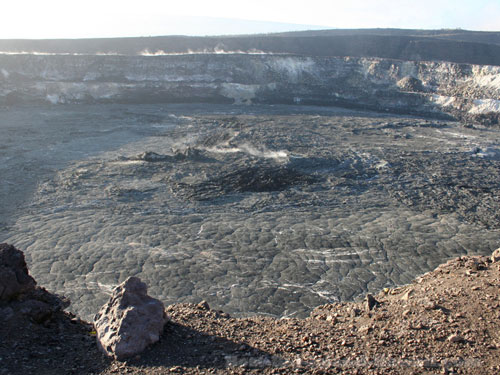 Most visitors will drive around the park to take in the various sights. The Crater Rim Drive is an 11 mile ring road that circles the Kilauea Caldera crater. It features various lookout points with spectacular views, steam vents, and the Jaggar Museum. The museum is open daily from 8:30 am to 7:30 pm and focuses on volcanoes and volcanic activity and also offers one of the best views of the crater.
Most visitors will drive around the park to take in the various sights. The Crater Rim Drive is an 11 mile ring road that circles the Kilauea Caldera crater. It features various lookout points with spectacular views, steam vents, and the Jaggar Museum. The museum is open daily from 8:30 am to 7:30 pm and focuses on volcanoes and volcanic activity and also offers one of the best views of the crater.
A tour of the park by car can also include the 20 mile Chain of Craters road, which takes you down 3,700 vertical feet from the crater to the volcanic rock sea cliffs where lava flows regularly into the ocean creating a spectacular show. All of the roads in the park are paved and accessible in any car—no need for four wheel drive here. But be sure to fill check your gas gauge as there's not gas available in the park. Running out of gas on your way down the Chain of Craters road will be a real drag. Off the Beaten Path For those who want to get off the beaten path and see more of the Hawaii Volcanoes National Park that what's easily viewable in a single day by car, the park has miles and miles of hiking trails for all abilities ranging from leisurely strolls for beginners to demanding routes for experienced trekkers. Plan ahead by visiting the park's website where you can learn about the various hikes available and also read visitor submitted journals describing some of the parks spectacular hikes.
Suggested Day Trips
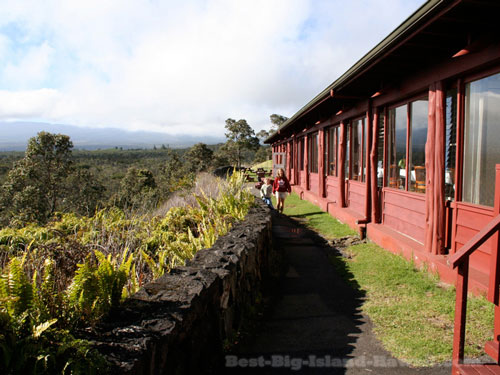 Half Day – Take a half day and begin by checking out the Visitor's Center. Listen to a Ranger talk and explore the various exhibits. Then take your time and drive around the Crater Rim Drive. Stop at the various sites and lookout points including the steam vents and the Jaggar Museum. Visiting the park in a half day will give you a taste of the sites and a memorable view of the huge crater. This is a great option for families with kids and those who want to learn something about Hawaii's volcanoes but don't necessarily want to make an expedition out of it.
Half Day – Take a half day and begin by checking out the Visitor's Center. Listen to a Ranger talk and explore the various exhibits. Then take your time and drive around the Crater Rim Drive. Stop at the various sites and lookout points including the steam vents and the Jaggar Museum. Visiting the park in a half day will give you a taste of the sites and a memorable view of the huge crater. This is a great option for families with kids and those who want to learn something about Hawaii's volcanoes but don't necessarily want to make an expedition out of it.
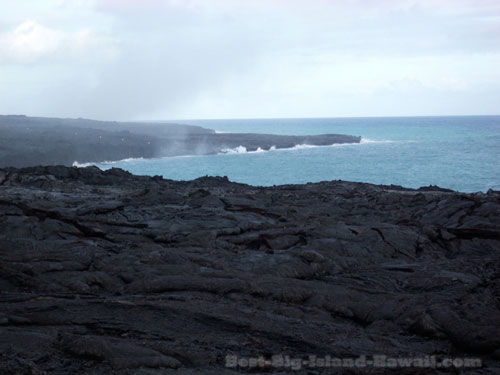 Full Day 1 – Take a full day and start with the Crater Rim Drive and continue on to the Chain of Craters Road in the afternoon. Bring a picnic lunch and stop at the picnic area at the Kealakomo overlook half way down the road. Continue descending towards the sea and stop at Pu`u Loa for a look at some of the thousands of petroglyphs drawings made in the volcanic rock by ancient Hawaiians. Then continue on to the end of the Chain of Craters Road where you can check out the area where the current lava flow ended the road abruptly. Find out if there will be viewable lava flows into the ocean. If so, stay until dark and sit in awe and silence as the sun sets and the lava lights up as it trickles into the sea. Drive back up the Chain of Craters Road in the dark and end your volcano experience by grabbing dinner at a restaurant in the town of Volcano, just a couple of miles from the park's main entrance. Relax and look at all the amazing pictures you took and maybe make plans to come back for another day—especially if there will be surface lava during your stay.
Full Day 1 – Take a full day and start with the Crater Rim Drive and continue on to the Chain of Craters Road in the afternoon. Bring a picnic lunch and stop at the picnic area at the Kealakomo overlook half way down the road. Continue descending towards the sea and stop at Pu`u Loa for a look at some of the thousands of petroglyphs drawings made in the volcanic rock by ancient Hawaiians. Then continue on to the end of the Chain of Craters Road where you can check out the area where the current lava flow ended the road abruptly. Find out if there will be viewable lava flows into the ocean. If so, stay until dark and sit in awe and silence as the sun sets and the lava lights up as it trickles into the sea. Drive back up the Chain of Craters Road in the dark and end your volcano experience by grabbing dinner at a restaurant in the town of Volcano, just a couple of miles from the park's main entrance. Relax and look at all the amazing pictures you took and maybe make plans to come back for another day—especially if there will be surface lava during your stay.
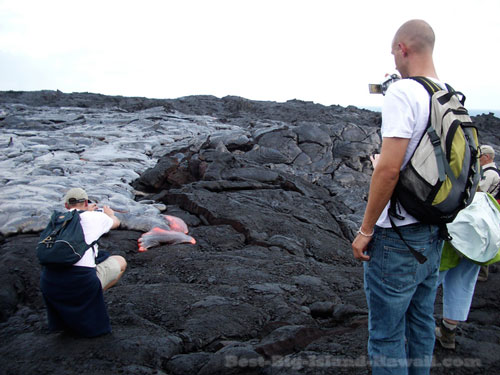 Full Day 2 – Or, if you know there will be viewable surface lava, save the Crater Rim Drive and its various sites for another visit and head straight down to the end of the Chain of Craters road. There's no rush, take your time and stop for a picnic and the petroglyphs, but be sure to get to the end of the road with enough time left to make your way out onto the lava flow in daylight. The Rangers at the end of the road will tell you how to view any accessible surface lava flows safely. Wear closed toe shoes suitable for the rocky terrain, wear layers, bring plenty of drinking water and a flashlight with extra batteries. Explore the surface lava with caution and stay until dark to take in the spectacular sight of red hot lava breaking though to the surface and flowing into the ocean. Follow the lighted beacons back to the road, carefully making your way in the dark. Then drive back up in the dark and enjoy that well-deserved dinner in the town of Volcano with a head and heart full of unforgettable memories of being present as new earth was created in your humble presence.
Full Day 2 – Or, if you know there will be viewable surface lava, save the Crater Rim Drive and its various sites for another visit and head straight down to the end of the Chain of Craters road. There's no rush, take your time and stop for a picnic and the petroglyphs, but be sure to get to the end of the road with enough time left to make your way out onto the lava flow in daylight. The Rangers at the end of the road will tell you how to view any accessible surface lava flows safely. Wear closed toe shoes suitable for the rocky terrain, wear layers, bring plenty of drinking water and a flashlight with extra batteries. Explore the surface lava with caution and stay until dark to take in the spectacular sight of red hot lava breaking though to the surface and flowing into the ocean. Follow the lighted beacons back to the road, carefully making your way in the dark. Then drive back up in the dark and enjoy that well-deserved dinner in the town of Volcano with a head and heart full of unforgettable memories of being present as new earth was created in your humble presence.
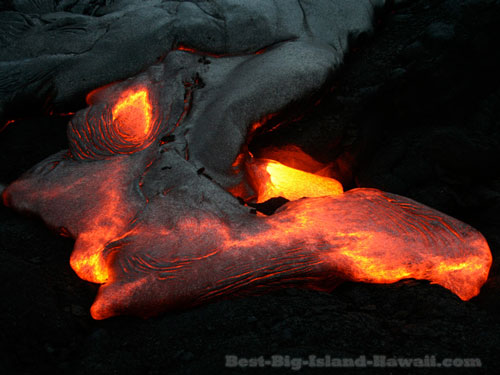
Time to go!
Be sure to make Hawaii's volcanoes and the Hawaii Volcanoes National Park a part of your visit to the Big Island—you won't be sorry! No matter how alluring the soft sand and warm blue waters of the Big Island's beaches are, it is well worth taking the time to explore the geological masterpiece that created the Big Island.
Be sure to check out the Hawaii Volcanoes National Park website for the latest updates, maps, schedules, and more activities!
While we've only scratched the surface here, hopefully this brief introduction will serve as a launching point for your visit to Hawaii Volcanoes National Park.
Go back from Hawaii Volcanoes National Park
to Hawaii Volcanoes




